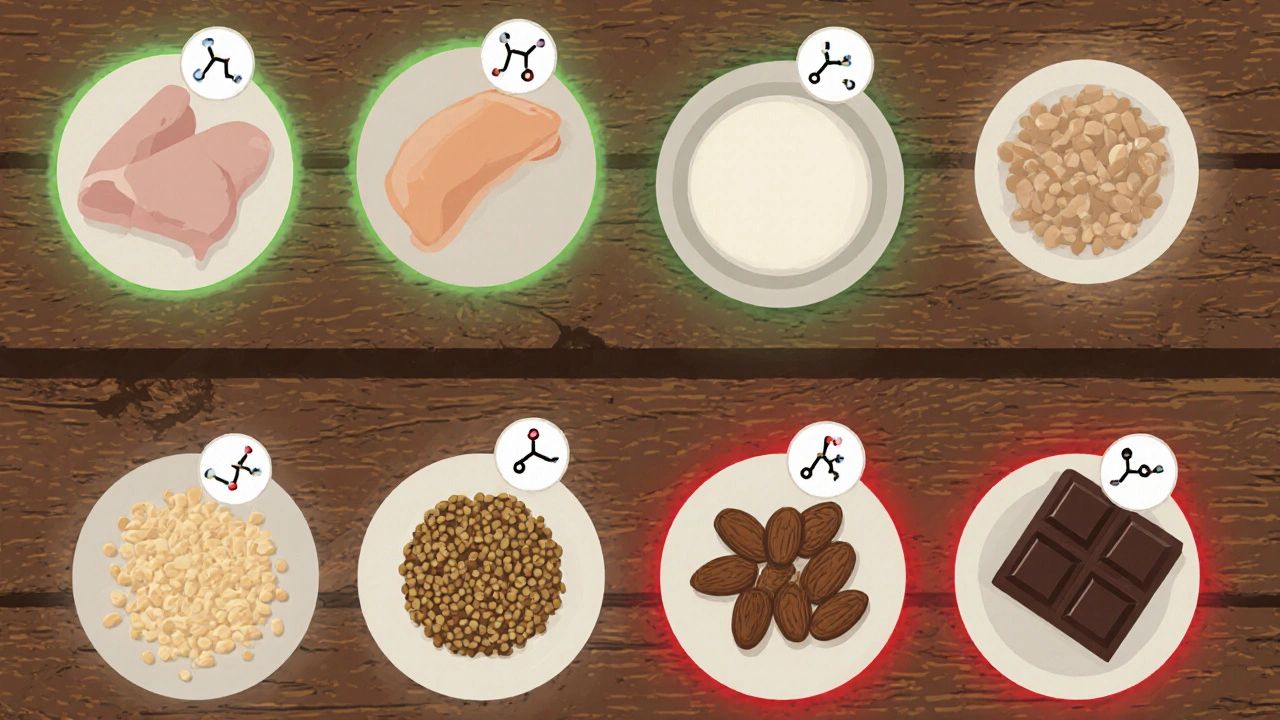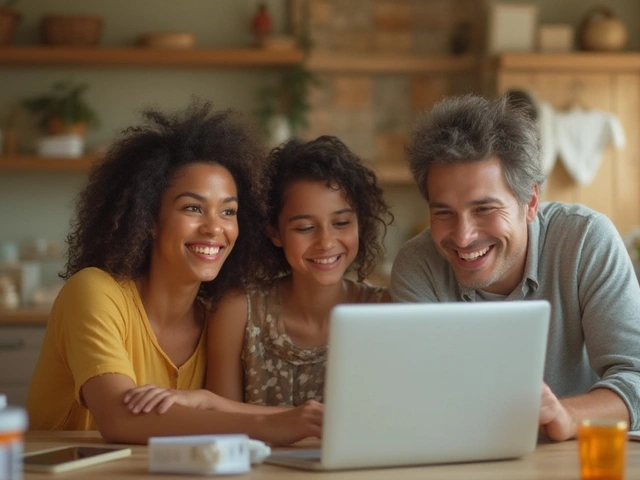Herpes Diet Food Comparison Tool
Lysine helps suppress herpes outbreaks by interfering with viral replication. Foods high in lysine include lean meats, dairy, legumes, and fish.
Arginine supports viral growth. High-arginine foods like nuts, seeds, and chocolate may increase outbreak risk.
| Food | Lysine (mg/100g) | Arginine (mg/100g) | Balance |
|---|---|---|---|
| Chicken Breast | 2,500 | 1,200 | Lysine-rich |
| Plain Yogurt | 600 | 300 | Lysine-rich |
| Cooked Lentils | 800 | 650 | Lysine-rich |
| Almonds | 200 | 2,300 | Arginine-rich |
| Dark Chocolate (70%) | 150 | 1,600 | Arginine-rich |
If you’ve ever felt the sting of a cold sore or the discomfort of genital herpes, you know how frustrating it can be when an outbreak pops up out of nowhere. While medication plays a central role, what’s on your plate can tip the balance between flare‑ups and calm days. This guide walks you through the science‑backed foods that help keep the virus in check and the culprits that can coax it out.
What the virus actually does
Herpes simplex virus (HSV) is a tiny DNA virus that lives in nerve cells and reactivates when conditions are right. Once you’re infected, the virus never truly leaves - it alternates between dormant periods and active replication, which shows up as the familiar sores. The trigger isn’t magic; it’s a mix of stress, hormonal swings, weakened immunity, and surprisingly, the foods you consume.
Why amino acids matter: Lysine vs. Arginine
Two amino acids sit at the heart of most diet recommendations: lysine an essential amino acid that interferes with viral replication and arginine an amino acid that the herpes virus uses to build new viral particles. When you tilt the balance toward lysine and away from arginine, you give your immune system a better chance to keep the virus silent.
Boosting the body’s natural defenses
Beyond the lysine‑arginine tug‑of‑war, a strong immune system the network of cells and proteins that fights infections is the best long‑term guard against outbreaks. Certain micronutrients act like ammunition for those immune soldiers.
- Vitamin C a water‑soluble vitamin that boosts white‑blood‑cell activity - found in citrus, strawberries, bell peppers.
- Zinc a trace mineral that supports skin integrity and antiviral immunity - abundant in pumpkin seeds, oysters, lentils.
Adding these nutrients to daily meals isn’t a cure, but it creates an environment where HSV struggles to reactivate.

Foods to load up on
Here’s a practical shopping list that leans heavily on lysine, vitaminC, and zinc while staying low in arginine.
- Lean poultry (chicken, turkey) - excellent lysine source.
- Low‑fat dairy (yogurt, cheese, milk) - provides both lysine and calcium.
- Legumes such as lentils and beans - pack lysine and zinc.
- Fish like salmon and cod - lysine plus omega‑3s for inflammation control.
- Whole‑grain breads (but not excessive sesame or wheat germ, which are higher in arginine).
- Fruits rich in vitaminC - kiwi, oranges, strawberries, papaya.
- Vegetables with high vitaminC and zinc - broccoli, spinach, bell peppers.
- Nuts low in arginine - macadamia nuts and walnuts (in moderation).
Mix these into balanced meals: a grilled chicken breast with a side of steamed broccoli and a kiwi for dessert does the trick.
Foods that can spark a flare‑up
While no single food guarantees an outbreak, some are consistently linked to higher arginine levels or inflammation, which can give HSV a foothold.
- Chocolate - beloved but high in arginine.
- Raw nuts (almonds, peanuts, cashews) - dense arginine content.
- Seeds (sesame, pumpkin, sunflower) - especially in large portions.
- Whole‑grain cereals that are heavy on wheat germ.
- Processed meats with added sugars and preservatives.
- Alcohol - dehydrates and weakens immunity.
If you enjoy these treats, don’t ditch them entirely; just keep portions modest and pair them with lysine‑rich foods to blunt the effect.
Quick‑look comparison: Lysine‑rich vs. Arginine‑rich foods
| Food | Lysine (mg per 100g) | Arginine (mg per 100g) |
|---|---|---|
| Chicken breast | 2,500 | 1,200 |
| Yogurt (plain) | 600 | 300 |
| Lentils (cooked) | 800 | 650 |
| Almonds | 200 | 2,300 |
| Chocolate (dark, 70%) | 150 | 1,600 |
Notice how the top three lysine‑rich options keep arginine relatively low. Swapping a handful of almonds for a serving of Greek yogurt can shift the balance dramatically.

Meal‑planning tips to keep the virus quiet
- Start with protein. Every main meal should feature a lysine‑rich protein - chicken, fish, tofu, or low‑fat dairy.
- Add a colorful veggie. VitaminC packed veggies not only improve immunity but also add bulk without extra arginine.
- Mind the snacks. When cravings hit, reach for a banana with a spoonful of natural peanut butter (use only a thin layer) or a small cup of yogurt with berries.
- Stay hydrated. Dehydration can worsen sores. Aim for at least 2liters of water a day, plus herbal teas like chamomile which have soothing properties.
- Consider timing. Some people report fewer outbreaks when they take a lysine supplement (1,000mg) after meals during high‑stress weeks. Talk to a healthcare professional before starting.
These habits are easy to insert into a busy routine and, over weeks, can make a noticeable difference.
When diet alone isn’t enough
If you’ve tried the herpes diet for a month and still see regular outbreaks, it’s time to combine nutrition with other strategies.
- Consult a dermatologist or infectious‑disease specialist for antiviral medication.
- Track triggers in a journal - stress, sleep, hormonal cycles, and even sun exposure matter.
- Practice good skin hygiene: keep the area clean, avoid touching sores, and use a lip balm with SPF.
- Maintain regular exercise - moderate activity boosts immunity without over‑training.
Think of diet as one piece of a larger puzzle that includes medical care, lifestyle, and mental well‑being.
Frequently Asked Questions
Can diet really affect herpes outbreaks?
Yes. Research and patient reports show that high‑arginine foods can fuel viral replication, while lysine‑rich foods and immune‑supporting nutrients can help keep the virus dormant. The effect isn’t instant, but consistent eating patterns often lead to fewer and milder flare‑ups.
What are the best lysine‑rich foods?
Top choices include chicken breast, turkey, low‑fat dairy (especially Greek yogurt and cottage cheese), fish like salmon, and legumes such as lentils and beans. A daily serving of any of these helps shift the lysine/arginine balance in your favor.
Which foods should I avoid during an outbreak?
Reduce intake of chocolate, raw nuts (especially almonds, peanuts, cashews), seeds, and excessive wheat‑germ cereals. Alcohol and heavily processed foods can also weaken the immune response, so cutting back during a flare‑up is wise.
How quickly can diet changes impact flare‑ups?
Most people notice a change within 2‑4weeks of consistent eating habits. The virus doesn’t disappear, but the frequency and severity of outbreaks often lessen as the body’s nutrient profile improves.
Are lysine supplements necessary?
Supplements can help if you struggle to get enough lysine from food, but they’re not mandatory. A typical dose is 1,000mg taken with a meal, and you should discuss it with a doctor, especially if you have kidney issues or are on medication.








Posts Comments
Joshua Logronio October 5, 2025 AT 14:43
Hey folks, just thought I'd drop a quick heads‑up – they don’t want you to know that the food lobby is pulling strings on these 'herpes diet' charts. The big dairy and meat conglomerates are sprinkling lysine tips everywhere so they can sell more chicken and yogurt. Keep your eyes peeled, it definately feels like a hidden agenda.
Nicholas Blackburn October 5, 2025 AT 20:16
Your post is riddled with vague statements. First, you claim lysine suppresses HSV without citing any peer‑reviewed meta‑analysis. Second, you ignore the fact that arginine is not the sole trigger; you’re oversimplifying complex virology. Also, your grammar suffers from comma misuse and you should fix that, even though you already have typos like sepereate and occurrance.
Dave Barnes October 6, 2025 AT 03:13
In the grand theatre of metabolism, lysine and arginine play opposing roles like protagonists and antagonists. If we view the diet as a script, each bite writes a line in the narrative of viral latency, and the subtle interplay suggests that balance is an art as much as a science.
Kai Röder October 6, 2025 AT 11:33
Thank you for sharing this balanced overview. For anyone starting out, pairing a serving of grilled chicken with vitamin‑C rich broccoli creates a nutrient synergy that supports immune function without overwhelming arginine intake.
Brandi Thompson October 6, 2025 AT 21:16
When people glance at a table of lysine versus arginine they often think they are merely choosing between tasty snacks and bland health foods.
What they fail to see is that each molecular decision ripples through a complex network of immune pathways that have been honed by evolution over millennia.
The herpes simplex virus, once lodged in the nerve ganglia, lies in a fragile equilibrium, waiting for a biochemical cue to awaken.
An excess of arginine can act like a signal flare, telling the dormant virus that conditions are favorable for replication.
Conversely, a diet enriched with lysine can tip the scales, making the cellular environment less hospitable for viral assembly.
This is not a magic bullet, however, because the body’s metabolism is influenced by countless variables beyond a single amino acid.
Stress hormones, sleep quality, and even the microbiome contribute their own notes to the symphony of viral control.
Therefore, focusing solely on the lysine‑arginine ratio without addressing these other factors is like trying to fix a leaky roof by only patching one shingle.
Nevertheless, pragmatic adjustments, such as choosing chicken over almonds or yogurt over chocolate, provide a tangible way to nudge the balance.
These food swaps are easy to incorporate into everyday meals and do not require expensive supplements.
People who consistently apply these changes often report fewer outbreaks, though the timeline varies from a couple of weeks to several months.
It is also important to recognize that individual responses differ, and some may find that even modest arginine intake triggers a flare.
For those individuals, a stricter avoidance strategy, perhaps limiting nuts and seeds, can be justified.
At the same time, eliminating all sources of arginine is neither realistic nor necessary for the majority.
A balanced approach, complemented by adequate vitamin C, zinc, and overall good health practices, yields the most sustainable results.
In sum, viewing diet as one piece of a multifaceted strategy empowers patients to take actionable steps without relying exclusively on medication.
Chip Hutchison October 7, 2025 AT 08:23
I love how this guide makes the science feel approachable – swapping a handful of almonds for Greek yogurt is a simple win, and the added vitamin C from fruit rounds it out nicely.
Emily Moody October 7, 2025 AT 20:53
Patriotic food warriors must defend our physiological borders by choosing lysine‑rich provisions, because every arginine‑laden morsel is a covert invasion of our cellular strongholds! The culinary battlefield demands bold, colorful choices that rally the immune ranks.
Prateek Kohli October 8, 2025 AT 10:46
Great info, thanks for sharing! 😊 Let’s all aim for a balanced plate and keep the vibes positive.
Noah Seidman October 9, 2025 AT 02:03
While many chase quick fixes, the real morality lies in respecting your body’s biochemical autonomy and refusing to let corporate snack manufacturers dictate your viral health.
Anastasia Petryankina October 9, 2025 AT 18:43
Oh brilliant, another revolutionary list of foods – because we were all completely lost before you told us that chicken has lysine. Truly groundbreaking.
Tim Ferguson October 10, 2025 AT 12:46
Sometimes the simplest advice is the best: eat more protein, get your vitamins, and stop stressing about every little detail.
Noah Cokelaere October 11, 2025 AT 08:13
Yeah, because you totally need a PhD in nutrition to avoid a cold sore. Good luck with that.
Ashley Helton October 12, 2025 AT 05:03
Nice roundup, really made me reconsider my midnight chocolate binge. Maybe I’ll just swap a piece for some yogurt next time.
Brian Jones October 13, 2025 AT 03:16
Great effort, really, the way you broke down lysine versus arginine, it’s like a mini‑lecture, and I appreciate it, keep it up!
Carlise Pretorius October 14, 2025 AT 02:53
i dont think i will stop eating almonds
Write a comment